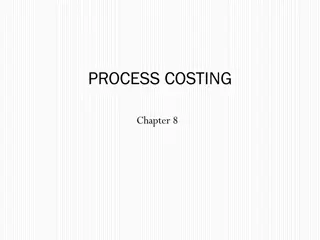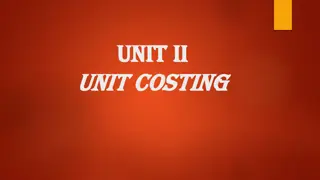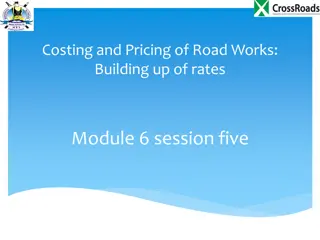Understanding Operating Costing in Business
Operating costing involves ascertaining costs for providing standardized services, aiding in efficiency, cost control, pricing decisions, and equipment maintenance. The objectives, unit of cost, and cost classifications are crucial components of this costing method.
Download Presentation

Please find below an Image/Link to download the presentation.
The content on the website is provided AS IS for your information and personal use only. It may not be sold, licensed, or shared on other websites without obtaining consent from the author. Download presentation by click this link. If you encounter any issues during the download, it is possible that the publisher has removed the file from their server.
E N D
Presentation Transcript
OPERATING COSTING M.VIJAYASEKARAM LECTURER IN COMMERCE S.V.C.R.GOVT DEGREE COLLEGE PALAMANER
MEANING OF OPERATING COSTING Operating ascertainment of cost for providing a standardized service to the public or to an undertaking. costing is a process and technique of accumulating and Definition of Operating Costing ICMA, London, Operating costing is that form of operation costing which applies where standardized services are provided either by an undertaking or by a service cost center within an undertaking. Wheldon, Operating costing is actually unit costing as applied to the costing of services.
OBJECTIVES OF OPERATING COSTING The objectives of operating costing are listed below: 1. To supply the information through which the efficiency in rendering service is improved. 2. To provide a basis for fixing accurate quotation and fare. 3. To ensure that the services are provided in proper time. 4. To control the fuel consumption and its expenses. 5. To ensure that the service equipments are properly maintained. 6. To provide cost comparison between own service and alternative service i.e. hiring. 7. To compare the cost of one service center with another. 8. To determine the apportionment cost if the services are provided within an organization. 9. To decide the price that can be charged for use of vehicle. 10. To control the cost of maintenance and repairs. 11. To select efficient and suitable routing of vehicles to reduce the costs to production departments that uses the service. 12. To avoid the under utilization of capacity and idle time of the work force. 13. To absorb the fixed costs proportionately and systematically that is allocated to the units of services.
UNIT OF COST: It is quite important to find out a proper unit of cost in case of operating cost so that the cost per unit can be ascertained. In certain cases the unit is obvious. For example in case of hospital it will be bed, in case of water works it will be 1000 litres, in case of electricity it will be a unit or kwh and in case of a retail store it will be the sale per Rs. 100 In case of transport concerns, however, the unit is likely to be composite. It may be a passenger-km. or ton-km signifying the effort which is made in carrying a passenger one kilometre or a ton of goods one km. Following are composite units based on two or more factors.
CLASSIFICATION OF COST: Operating costs are classified and accumulated under the following three heads: (a) Fixed or Standing Charges: These are expenses which are more or less fixed in nature. For example in case transport service garage charges, insurance, taxes, license and depreciation are standing cost. In case of Hospital the depreciation pertaining to the cost of building, equipment, beds, beds insurance etc. are fixed charges. These expenses are constant and are incurred irrespective of the extent of service. (b) Maintenance Charges: These are costs of semi-variable nature and include expenditure on repairs, maintenance, tyres, tubes, accessories and spares.























